QAM is the technology cable companies use to send digital TV to your home. Cable companies are unique in using this technology, which dates back to the 1980s. Satellite TV companies use DSS technology and fiber companies (Verizon, AT&T, etc.) use TCP/IP for the same purpose.
One of the unique things about QAM is that even though each QAM channel is the same size, you can fit as many TV channels as you want within it. This means that even though the cable company may only have the ability to send 80 channels through its cables, each of those channels could have 8 channels within it, giving the system the ability to show 640 channels.
That sounds great, right? But remember what author Robert Heinlein said: “There Ain’t No Such Thing As A Free Lunch.” Something has to give and it’s usually quality.
Each QAM channel could carry one Blu-ray quality stream if the cable company wanted. Of course, that means that there would only be 80 channels. Or, it can carry two full-quality off-air broadcasts, but that would limit you to 160 channels. That may sound like a lot but when you’re competing with satellite and fiber providers who offer 500 or more channels, you need to do better or you’ll lose customers.
So, they pack more and more content into each HD channel and the result is a poorer quality signal. Sure, they can advertise 500 channels but each one is barely better than standard definition.
How can you tell if the cable company is ripping you off? Here are some telltale signs:
If you are using a traditional cable TV company (Comcast, Time Warner etc.) and they offer 500 channels. There simply isn’t enough room in the cable company’s signal for that without destroying quality.
If you see noticeably worse quality than your neighbors such as pixelation, gamut compression, bitstarving, macroblocking, or other HD “artifacts” you know they come from cable not from the provider. These are sure indicators that the quality of the HD picture is artificially adjusted.
If the picture becomes jerky during unexpected times this can be a sign of low quality or errors that were put in while the cable company was processing the signal.
It’s true that satellite and fiber providers generally compress their signals too but you don’t see it as much when it gets to the TV. Satellite providers use variable bit rate technology so that every channel gets just as much space as it needs at the time. Cable companies need to tune every channel to the same size. Fiber providers have a lot more room to transmit channels and just don’t need to compress them down as much as cable.
If you’re paying over $150 a month for cable, you really ought to get what you’re paying for. If you’re not happy with the picture you’re seeing, it’s probably because your outdated cable company is trying to shove too much onto their wires and the answer is simple: change providers.



